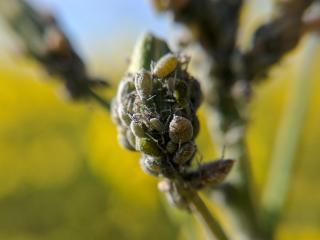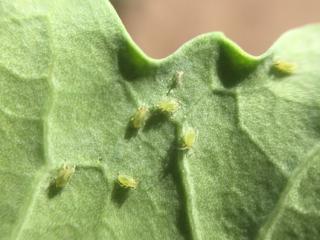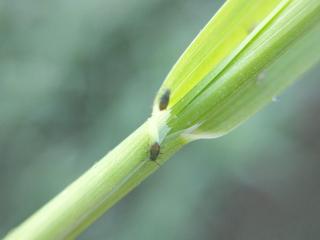Aphid activity is expected to increase in spring
Canola aphids
- Kellerberrin
- Cuballing
- Wagin
- Dumbleyung
- Katanning
A farmer near Kellerberrin reports that canola aphids are being found in increasing numbers in some canola crops. The farmer noted that the aphid numbers were getting close to threshold levels in a Bonito canola crop, while numbers were much lower in the nearby Stingray canola crop.
While in the field this week entomologists Dusty Severtson (DPIRD) and Alan Lord (DPIRD) found varying densities of cabbage aphids on early flowering canola plants near Cuballing, Wagin and Katanning. They found some parasitised cabbage aphids on canola plants near Wagin.
Dusty and Alan also found clusters of turnip aphids along the edge of an early flowering canola crop near Wagin.
Last week Dusty reported finding green peach aphids (GPA) dying from fungus on the underside of early flowering canola plants near Katanning.
Theo Van Niekerk (Katanning Soil Nutrition Service) has reported finding GPA and cabbage aphids in an early flowering Stingray canola crop near Dumbleyung.
Growers are urged to check canola crops for fungal infections and parasitisation in aphids before deciding to invest in an insecticide spray. For more information see the department’s Know what beneficials look like in your crop.
Growers, consultants and other field operators that would like to know how close they are to the canola aphid threshold and where across crops this is occurring can download the new CropScout app which designed to assist inspection of canola for aphids relative to the spray threshold and easily record and visualise results on a map. This field intelligence can then be used to optimise spray timing and, where possible, to target sprays to pest infestations across properties or within individual crops. For more information, see the department’s CropScout page.
Cereal aphids
- Cunderdin
- Katanning
Plant pathologist Geoff Thomas (DPIRD) reports that high numbers of corn aphids are in his barley trial at Cunderdin.
Entomologist Dusty Severtson (DPIRD) has found oat aphids on some leaves in a barley crop near Katanning (Woodanilling).
Cereal aphids have not been reported to PestFax much so far this season and aphid outbreaks seem to be isolated to certain crops which may have had aphids colonise crops early from volunteer cereal and grass plants. However, aphid populations can increase rapidly with increased temperatures as we head into spring as well as reproductive phases of crop plants providing nutrients for the aphids.
Growers are advised to inspect their cereal crops for aphids, especially along crop edges where they tend to colonise first and form hotspots.
Growers are also urged to identify cereal aphid species and monitor for the exotic Russian wheat aphid whose presence was confirmed in South Australia, Victoria, New South Wales and Tasmania in 2016. For more information refer to the 2017 PestFax Issue 11 article Check paddocks for Russian wheat aphid as well as the usual cereal aphids.
For more information on aphids refer the department’s;
- Protecting WA Crops Issue 3 newsletter Aphids – WA’s insect problem children
- Aphid management in canola crops page
- Diagnosing cereal aphids page.
For a list of insecticides registered for use on aphids in canola and cereals see the department’s Winter/Spring Insecticide Guide 2017.
For more information contact Svetlana Micic, Research Officer, Albany on +61 (0)8 9892 8591 or Dustin Severtson, Development Officer, South Perth on +61 (0)8 9368 3249.



